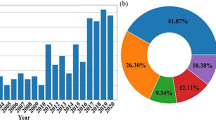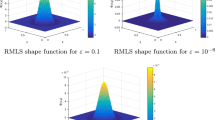Abstract
The meshless Shepard and least squares (MSLS) method and the meshless Shepard method are partition of unity based meshless interpolations which eliminate the problems by other meshless methods such as the difficulty in direct imposition of the essential boundary conditions. However, singular weight functions have to be used in both methods to enforce the approximation interpolatory, which leads to the loss of smoothness in approximation and locally oscillatory results. In this paper, an improved MSLS interpolation is developed by using dually defined nodal supports such that no singular weight function is required. The proposed interpolation satisfies the delta property at boundary nodes and the compatibility condition throughout the domain, and is capable of exactly reproducing the basis function. The computational cost of the present interpolation is much lower than the moving least-squares approximation which is probably the most widely used meshless interpolation at present.

















Similar content being viewed by others
References
Belytschko T, Krongauz Y, Organ D (1996) Meshless methods: an overview and recent developments. Comput Methods Appl Mech Eng 139:3–47
Fries T, Matthies H (2004) Classification and overview of meshfree methods. Technical report. Technical University Braunschweig, Braunschweig
Nguyen V, Rabczuk T, Bordas S, Duflot M (2008) Meshless methods: a review and computer implementation aspects. Math Comput Simul 79:763–813
Zhang Z, Liew KM, Cheng YM, Li YY (2008) Analyzing 2D fracture problems with the improved element-free Galerkin method. Eng Anal Boundary Elem 32:241–256
Liew KM, Cheng YM, Kitipornchai S (2007) Analyzing the 2D fracture problems via the enriched boundary element-free method. Int J Solids Struct 44:4220–4233
Long SY, Liu KY, Li GY (2008) An analysis for the elasto-plastic fracture problem by the meshless local Petrov–Galerkin method. Comput Model Eng Sci 28:203–2167
Rabczuk T, Belytschko T (2004) Cracking particles: a simplified meshfree method for arbitrary evolving cracks. Int J Numer Methods Eng 61(13):2316–2343
Rabczuk T, Belytschko T, Xiao SP (2004) Stable particle methods based on Lagrangian kernels. Comput Methods App Mech Eng 193(12–14):1035–1063
Rabczuk T, Zi G (2007) A meshfree method based on the local partition of unity for cohesive cracks. Comput Mech 39(6):743–760
Rabczuk T, Belytschko T (2007) A three dimensional large deformation meshfree method for arbitrary evolving cracks. Comput Methods App Mech Eng 196(29–30):2777–2799
Rabczuk T, Bordas S, Zi G (2010) On three-dimensional modelling of crack growth using partition of unity methods. Comp Struct 88(23–24):1391–1411
Chau-Dinh T, Zi G, Lee PS, Song JH, Rabczuk T (2012) Phantom-node method for shell models with arbitrary cracks. Comp Struct 92-93:242–256
Krysl P, Belytschko T (1996) Analysis of thin shells by the element free Galerkin method. Int J Numer Methods Eng 33:3057–3078
Chen JS, Pan C,Wu CT, Liu WK (1996) Reproducing kernel particle methods for large deformation analysis of nonlinear structures. Comput Methods Appl Mech Eng 139:195–227
Heaney CE, Augarde CE, Deeks AJ (2010) Modelling elastoplasticity using the hybrid MLPG method. Comput Model Eng Sci 56:153–178
Rabczuk T, Gracie R, Song JH, Belytschko T (2010) Immersed particle method for fluid-structure interaction. Int J Numer Methods Eng 81(1):48–71
Wang JG, Liu GR, Lin P (2002) Numerical analysis of Biot’s consolidation process by radial point interpolation method. Int J Solids Struct 39:1557–1573
Li S, Liu W, Rosakis A, Belytschko T, Hao W (2002) Mesh-free Galerkin simulations of dynamic shear band propagation and failure mode transition. Int J Solids Struct 39:1213–1240
Talebi H, Samaniego C, Samaniego E, Rabczuk T (2012) On the numerical stability and mass-lumping schemes for explicit enriched meshfree methods. Int J Numer Methods Eng 89(9):1009–1027
Rabczuk T, Samaniego E (2008) Discontinuous modelling of shear bands using adaptive meshfree methods. Comput Methods App Mech Eng 197(6-8):641–658
Han ZD, Atluri SN (2004) Meshless local Petrov–Galerkin (MLPG) approaches for solving 3D problems in elasto-statics. Comput Model Eng Sci 6:169–188
Zhuang X, Augarde C, Mathisen K (2012) Fracture modelling using meshless methods and level sets in 3D: framework and modelling. Int J Numer Methods Eng 92:969–998
Liu WK, Han W, Lu H, Li S (2004) Reproducing kernel element method. Part I. Theoretical formulation. Comput Methods Appl Mech Eng 193:933–951
You Y, Chen JS (2003) Reproducing kernel, and adaptive meshfree methods. Comput Mech 31:316–326
Wu CT, Park CK, Chen JS (2011) A generalized approximation for the meshfree analysis of solids. Int J Numer Methods Eng 85:693–722
Lancaster P, Salkauskas K (1981) Surfaces generated by moving least squares methods. Math Comput 37:141–158
Breitkopf P, Rassine A, TouzotG (2000) Explicit form and efficient computation of MLS shape functions and their derivatives. Int J Numer Methods Eng 48:451–466
Zhuang X, Augarde C (2010) Aspects of the use of orthogonal basis functions in the element free Galerkin method. Int J Numer Methods Eng 81:366–380
Kaljevic I, Saigal AS (1997) An improved element free Galerkin formulation. Int J Numer Methods Eng 40:2953–2974
Atluri SN, Kim HG, Cho JY (1999) A critical assessment of the truly meshless local Petrov–Galerkin and local boundary integral equation methods. Comput Mech 24:348–372
Krongauz Y, Belytschko T (1997) Consistent pseudo-derivatives in meshless methods. Comput Methods Appl Mech Eng 146:371–386
Macri M, De S (2008) An octree partition of unity method (Oct- PUM) with enrichments for multiscale modeling of heterogeneous media. Comput Struct 86:780–795
Griebel M, Schweitzer MA (2000) A particle-partition of unity method for the solution of elliptic, parabolic, and hyperbolic PDEs. SIAM J Sci Comput 22:853–890
Griebel M, Schweitzer MA (2002) A particle-partition of unity method–Part II: efficient cover construction and reliable integration. SIAM J Sci Comput 23:1665–1682
Griebel M, Schweitzer MA (2002) A particle-partition of unity method–Part III: a multilevel solver. SIAM J Sci Comput 24:377– 409
Cai YC, Zhu HH (2008) A local meshless Shepard and least square interpolation method based on local weak form. Comput Model Eng Sci 34:179–204
Cai YC, Zhu HH (2010) A PU-based meshless Shepard interpolation method satisfying delta property. Eng Anal Boundary Elem 34:9–16
Oden JT, Durate CA, Zienkiewicz OC (1998) Anewcloud-based hp finite element method. Comput Methods Appl Mech Eng 153:117–126
Liu GR, Gu YT, Dai KY (2004) Assessment and applications of point interpolation methods for computational mechanics. Int J Numer Methods Eng 59:1373–1397
Collier C, Pardo D, Dalcin L, Paszynski M, Calo VM (2012) The cost of continuity: a study of the performance of isogeometric finite elements using direct solvers. Comput Methods Appl Mech Eng 213–216:353–361
Zhuang X, Heaney C, Augarde C (2012) On error control in the element-free Galerkin method. Eng Anal Boundary Elem 36:351–360
Belytschko T, Lu YY, Gu L (1994) Element-free Galerkin method. Int J Numer Methods Eng 37:229–256
Rice J (1968) A path independent integral and the approximate analysis of strain concentration by notches and cracks. J Appl Mech 35:379–386
Portela A, Aliabadi M, Rooke D(1992) The dual boundary element method–effective implementation for crack problems. Int J Numer Methods Eng 33:1269–1287
Murakami Y (1987) The stress intensity factors handbook. Pergamon Press, Oxford
Zhuang X, Augarde C, Bordas S (2011) Accurate fracture modelling using meshless methods and level sets: formulation and 2D modelling. Int J Numer Methods Eng 86:249–268
Acknowledgments
The authors gratefully acknowledge the support of Natural Science Foundation of China (NSFC 41130751), National Basic Research Program of China (973 Program: 2011CB013800), Program for Changjiang Scholars and Innovative Research Team in University (PCSIRT, IRT1029), Shanghai Pujiang Talent Program (12PJ1409100) and Shanghai Chenguang Talent Program (12CG20).
Author information
Authors and Affiliations
Corresponding author
Rights and permissions
About this article
Cite this article
Zhuang, X., Zhu, H. & Augarde, C. An improved meshless Shepard and least squares method possessing the delta property and requiring no singular weight function. Comput Mech 53, 343–357 (2014). https://doi.org/10.1007/s00466-013-0912-1
Received:
Accepted:
Published:
Issue Date:
DOI: https://doi.org/10.1007/s00466-013-0912-1




